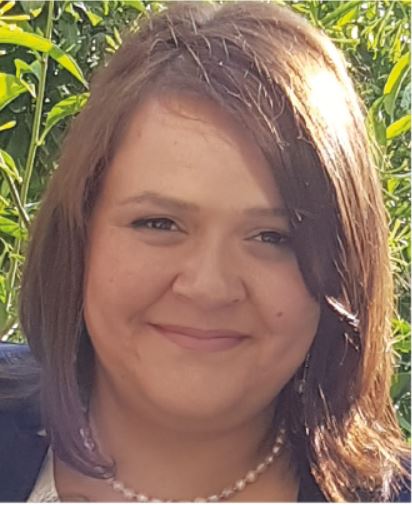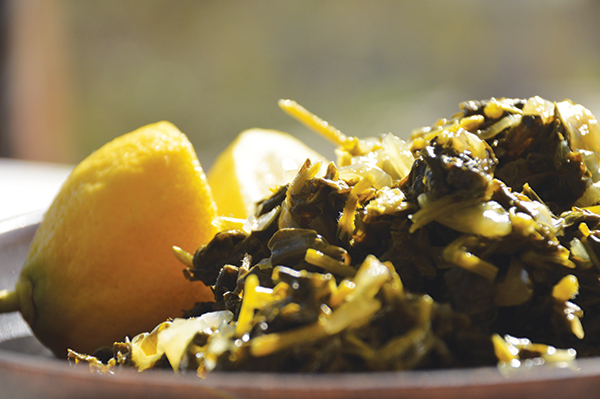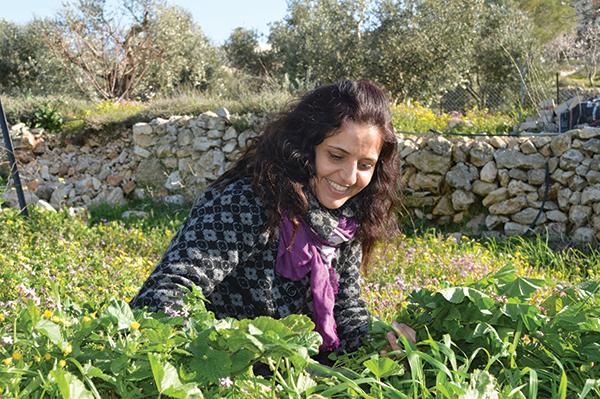“Khobaizeh (mallow) carries the DNA of our heritage,” said Vivien Sansour. She stood by her kitchen counter cutting green velvety khobaizeh leaves that we had just picked in Al-Walajeh, a small village outside of Beit Jala. Al-Walajeh was once a green haven and a productive agricultural community. Today, however, the village is strangled by the Israeli Segregation Wall and the systematic illegal confiscation of land. The people of Al-Walajeh have been displaced three times: once in 1948, again in 1967, and more recently, as the Wall came cutting through their lands and homes. Three generations of refugees with first-person memory reside here. Three generations tell the story of the Palestinian diaspora and punctuate it with semicolons of lettuce, fijel, fool, and, of course, khobaizeh.
Vivien is a dear friend, an agriculture specialist, and an avid forager. When she talks about edible wild plants, I feel as though my own grandmother were talking to me. She is knowledgeable and passionate about the land; not the symbolic land but the actual physical soil, rocks, plants, and animals, and all the bounty – from wild plants to cultivated produce – that makes its way into our kitchens and onto our cooking counters. To Vivien cooking isn’t an isolated incident that happens in a well-lit kitchen with stainless steel counters and razor-sharp knives. To her, cooking is a direct relationship between the land, human experience, and the table. It is an expression of trust between humankind and Mother Nature.
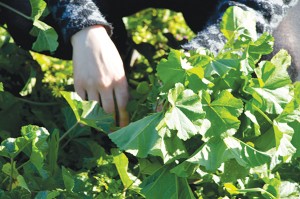 Like many cuisines around the Mediterranean region and the world, Palestinian cuisine begins with edible wild plants, a fact that relates painfully to forced alienation from ancestral lands, most forcefully in 1948. Nakba narrative focuses on displacement and dispossession. Palestinian refugees who were expelled from their villages and survived for days in hills and fields as they walked from one destroyed village to the next often relate that they ate hindbeh, lufaiteh, huwairneh, and of course, khobaizeh. In other words, they foraged their way to survival. While foraging may seem to be the latest trend in gastronomy, here it is an age-old craft; it is a way of life, and it is where our cooking originates. It is what our ancestors did in the privacy of their kitchens, away from fancy cooking shows and gregarious food writers.
Like many cuisines around the Mediterranean region and the world, Palestinian cuisine begins with edible wild plants, a fact that relates painfully to forced alienation from ancestral lands, most forcefully in 1948. Nakba narrative focuses on displacement and dispossession. Palestinian refugees who were expelled from their villages and survived for days in hills and fields as they walked from one destroyed village to the next often relate that they ate hindbeh, lufaiteh, huwairneh, and of course, khobaizeh. In other words, they foraged their way to survival. While foraging may seem to be the latest trend in gastronomy, here it is an age-old craft; it is a way of life, and it is where our cooking originates. It is what our ancestors did in the privacy of their kitchens, away from fancy cooking shows and gregarious food writers.
♦ “In al-khala (nature), I reconnect to an earlier way of being – before agriculture existed – without the need to control our surroundings, but rather with complete faith that it will provide. We may have gained some things with the transition to agriculture, but we lost some of our instinctual trust.” Vivien
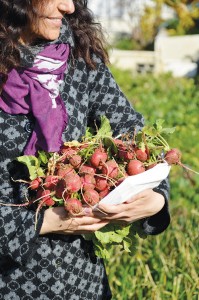 On that day in Al-Walajeh, I was in search of many things. I wanted to begin telling the story of Palestinian food away from all that is stereotypical and mainstream; I was also searching for my own self; my own relationship to Palestine, its land and food, and the meaning that such a relationship might carry in its folds. I, with my formal education, which by all accounts should have taken me away from the kitchen, found myself gravitating towards it. Vivien believes that the ancient community-held knowledge of plants, food, and agriculture that is present in places such as Al-Walajeh, and more importantly in the people of Al-Walajeh, is precious knowledge that is worth seeking and defending. As a young girl, I was pushed out of the kitchen. My mother’s response was always “Miliha‘aalaal-tabeekh (you still have time before you start cooking), roohy odrosy (go do your homework).” My mother systematically pushed us out of the kitchen and preferred that we read books rather than make our beds or learn to do laundry. Vivien’s mother was not that different; Vivien recalls being thrown out of the kitchen. The extent of our relationship with cooking was to fetch missing ingredients for the dishes our mothers were expertly cooking. Having developed my own interest in food and food writing, I still see the disapproving looks my mother gives me when I express my passion for msakhan or mansaf, or when I post photos of mabroosheh and ka’ak bi ajweh on Facebook.
On that day in Al-Walajeh, I was in search of many things. I wanted to begin telling the story of Palestinian food away from all that is stereotypical and mainstream; I was also searching for my own self; my own relationship to Palestine, its land and food, and the meaning that such a relationship might carry in its folds. I, with my formal education, which by all accounts should have taken me away from the kitchen, found myself gravitating towards it. Vivien believes that the ancient community-held knowledge of plants, food, and agriculture that is present in places such as Al-Walajeh, and more importantly in the people of Al-Walajeh, is precious knowledge that is worth seeking and defending. As a young girl, I was pushed out of the kitchen. My mother’s response was always “Miliha‘aalaal-tabeekh (you still have time before you start cooking), roohy odrosy (go do your homework).” My mother systematically pushed us out of the kitchen and preferred that we read books rather than make our beds or learn to do laundry. Vivien’s mother was not that different; Vivien recalls being thrown out of the kitchen. The extent of our relationship with cooking was to fetch missing ingredients for the dishes our mothers were expertly cooking. Having developed my own interest in food and food writing, I still see the disapproving looks my mother gives me when I express my passion for msakhan or mansaf, or when I post photos of mabroosheh and ka’ak bi ajweh on Facebook.
For us – like it is for many, even if we don’t consciously know it – cooking can sometimes be an act of resistance. Given that cooking is directly tied to the land, and the land is a vanishing body, it is only natural that we hang on to our old recipes and traditional dishes. We need to take an interest in our cuisine, which seems to be becoming less ours and more theirs (the Israelis’). With the fading landscape there are disappearing edible wild plants that have adorned our tables for generations and that are slowly becoming scarcer on our lunch and dinner tables. Food, then, is not an isolated hedonistic pleasure; it is culture, tradition, heritage, and identity.
When people are displaced, they leave behind all that is physical and carry with them all that is metaphorical. They carry their identity tenderly and protect it from time, loss, and forgetfulness. Food becomes an act of remembrance; and cooking, then, feeds hungry mouths and more. It is no longer tied to a woman’s traditional role. It is, rather, a resistance tool, a ritual of return to the Palestine we love and long for, a measure of perseverance. When I first talked to Vivien about this piece, we chose khobaizeh because it was in season, but the more I learned about it, the more I realized that khobaizeh is much more than a weed that grows on the side of the road.
Khobaizeh is not native only to Palestine. In fact, it is found almost everywhere in the world – from sunny Californian sidewalks to ancient Chinese temples. In the Mediterranean area, however, people are known to cook and eat khobaizeh in various recipes. In Palestine, this is the one dish that everyone eats at least once in his or her lifetime. It is the one dish that everyone hates during childhood but loves in adulthood. Khobaizeh is the coming-of-age dish. It is the dish you fall in love with as an adult because you finally fall in love with Palestine, and it finally dawns on you why your parents spent years explaining to you why you should be Palestinian; why you should come home after finishing that university degree; and why your PhD means a lot more here than in Europe, the United States, or anywhere else in the world. Khobaizeh is a Palestinian dish, and it embodies everything about Palestinian cuisine.
Khobaizeh represents resilience and return. It comes back every year, no matter how many times it is cut. We can trust khobaizeh to be there, right under the fig tree, right beside the lettuce head, right by the side of the road. It sprouts everywhere, no matter how harsh the conditions. It sends roots into the ground and refuses to leave. Khobaizeh is symbolic of all that is Palestinian, the determination to live despite all, to exist, to stay, and to never leave. Khobaizeh is Mother Nature’s way of saying to us, “Trust me, I will provide for you.”
♦ “During the first Intifada, people turned their little backyards into small farms. We planted tomatoes, lettuce, spinach, and many other greens. We ate our own produce and boycotted Israeli produce and products. I was a child back then, and whether my mother knew this or not, her kitchen was a tool of resistance at the time.” Riyam
Before we became modern societies, when we were hunters and gatherers, we trusted nature, we ate whatever was available in the wild. We trusted that Mother Nature would provide for us every day of the year, every season. We trusted her to give us what we needed. As humans became more domesticated and more modernized, I think, we lost that trust. Vivien believes that this trust is forcibly broken in the world in general and in Palestine in particular because of the writhing metropolises that are expanding into natural habitats, as well as the brutal Israeli occupation practices against the land and the cancerous illegal settlements that are erected on hilltops. The end result is a shrinking wild habitat and dwindling agricultural land. Farmers are intentionally targeted by land confiscation, olive-tree uprooting, and water shortage. We no longer trust that the land can provide for us regardless of whether we cultivate it or walk through it to pick all that is edible. When I asked Vivien why she cooked, she said that it was because she wanted to restore that trust. She wanted to protect her own heritage and inherit the know-how of Palestinian cuisine from our elders “because, for now, we have them to ask for help. But when they are long gone and our children are trying to cook their food, who will they ask?” And then I think and wonder, “How will they teach their own children that khobaizeh is not just a dish to hate when you are young, like broccoli and cauliflower, but rather a story of resilience and resistance?”
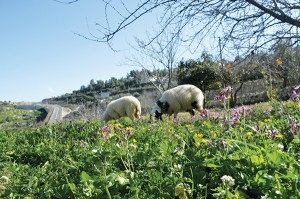 Palestinians seem to have fewer and fewer tools to resist Israeli occupation. Kitchens are intimate spaces were families share their stories and pass on knowledge and history. We spring from our own dishes, and rarely are our dinner tables devoid of stories of the 1948 Nakba or the 1967 Naksa. It is food that brings us together, and it is food that will keep us together. It is khobaizeh insistently returning every year that will stand witness to villages that existed and to a people that lived and continue to live. In her article on ethnobotany, Vivien recalls the village of Imwas through the small pomegranate, fig, and olive trees growing silently underneath the cedar and pine trees in Canada Park, built on the ruins of Imwas. The people of Imwas have been forced out, the stone houses are nothing but dust blowing in the wind, and Imwas may no longer be recognizable, but it is our own trees that will remain “to stand witness to an unperfected crime.”
Palestinians seem to have fewer and fewer tools to resist Israeli occupation. Kitchens are intimate spaces were families share their stories and pass on knowledge and history. We spring from our own dishes, and rarely are our dinner tables devoid of stories of the 1948 Nakba or the 1967 Naksa. It is food that brings us together, and it is food that will keep us together. It is khobaizeh insistently returning every year that will stand witness to villages that existed and to a people that lived and continue to live. In her article on ethnobotany, Vivien recalls the village of Imwas through the small pomegranate, fig, and olive trees growing silently underneath the cedar and pine trees in Canada Park, built on the ruins of Imwas. The people of Imwas have been forced out, the stone houses are nothing but dust blowing in the wind, and Imwas may no longer be recognizable, but it is our own trees that will remain “to stand witness to an unperfected crime.”
♦ It seems so frivolous to be a Palestinian food writer; at the same time almost offensive to and detached from the starving children of Al-Yarmouk and Gaza. “But when we go in there saying, ‘We actually want to see you make maklouba,’ so much other stuff comes along with it. In the course of making maklouba, we would hear about Um Sultan’s farm by the border that was razed by Israeli armored bulldozers two different times, forcing them to relocate, and how that impacted their lives. So you get the back stories.” –Laila El Haddad, co-author of The Gaza Kitchen: A Palestinian Culinary Journey.
We are so in love with Palestine, we carry maps of her in gold and silver necklaces that nestle on top of our hearts. We write poetry about her, we mourn her loss, we fight for her. We lose our loved ones for her, we teach our children to never question her. But what is Palestine, if it is not soil, ecosystems, wild plants and animals, agriculture, and of course food? What is Palestine without the seasonal sautéed khobaizeh dish topped with crunchy onions and cooked by our elders – our mothers and grandmothers – and the young – Vivien and me?
» Riyam Kafri AbuLaban is one of This Week in Palestine’s content editors. She holds a PhD in organic chemistry from the University of Tennessee. Her research interests span a wide spectrum that includes computer-based drug design, philosophy and science, art science, and education. She is an aspiring writer with contributions to Mashallah News, Brownbook, and This Week in Palestine. Samples of her writing appeared recently in a book on Palestinian narrative titled Palestine Speaks: Narratives of Life Under Occupation (Voice of Witness). Riyam is currently working on a food memoire/cookbook so delicious you will lick the pages. She can be reached at riyam.kafri@gmail.com.
Article photos by Vivien Sansour and Ayad Arafeh.

